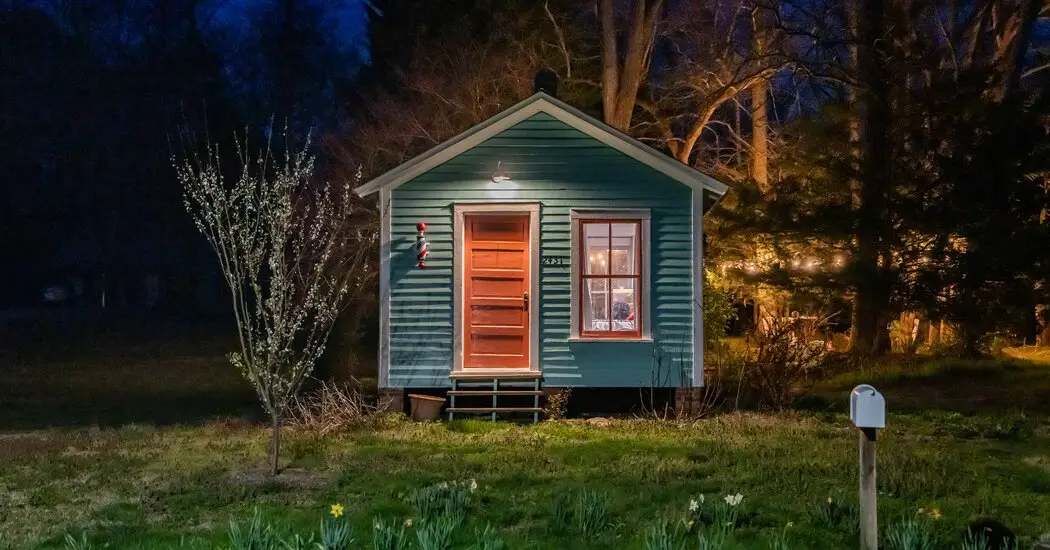If there is a word for people who behave like terriers, tucking themselves into cramped spaces that would drive others into fits, it probably has not been invented. But it would describe Liz Gilson.
Born in France to American parents, Ms. Gilson spent several childhood years living in a stately home in England where she begged to move her bedroom into a tiny storage room in the attic. Later, she was a sailor and boatyard worker in Australia.
“In my 20s, I lived on a 26-foot sailboat for five years and loved it; it was just the coziest, happiest time,” she recalled.
“And then in my 30s,” she continued, “I fitted out a furniture-moving van and traveled to the east coast of Australia by road. And a friend of mine painted flowers on the outside. And I got run out of a town in the deep north because I was a hippie. But that was lovely, too.”
In her 40s, Ms. Gilson bought a Dodge Ram van that a previous owner had lined in red velvet and embarked on a two-month trip to visit family members in the United States. The trip lasted two years. The vehicle was her primary home; when she needed to work at her job as a proofreader, she stopped at public libraries.
Now, following a stretch of marriage during which she occupied houses that sat firmly on their foundations and required numerous strides to cross, she is divorced and back to her old ways. Six years ago, she bought a tiny house in North Carolina that was once a barbershop. She paid $70,000. The only storage was a single, six-inch-wide drawer that was presumably where the mustache combs had been kept.
Ms. Gilson, who is 70 and works as a director of client services for companies that coach corporations, swears she will never leave.
Her forever home is in Glencoe Mill Village, a community on 105 acres in Burlington, N.C., that developed around a cotton mill in the early 1880s. After the mill closed in 1954, the brick factory buildings and three dozen or so little workers’ houses hung around. The property attracted enough respect as a relic of North Carolina’s once-formidable textile industry to be listed in 1978 on the National Register of Historic Places, but it was almost completely abandoned and in poor condition.
In 1997, Preservation North Carolina, a nonprofit, bought the village and put the houses up for sale with the stipulation that, in restoring them, new owners had to maintain their historical character. The original wood siding and windows were to be kept or replicated, for example. And any additions — which were badly needed, given that most of the houses lacked bathrooms and kitchens — had to be in back, to preserve a uniform look from the street side.
When Ms. Gilson acquired the village barbershop, the previous owner had already installed an addition to the one-room building, bringing the total floor area to about 345 square feet. Using funds from a preservation grant, Ms. Gilson refreshed the light blue exterior paint, and after a disappointing flirtation with fire-engine red as a trim color, shifted to tomato.
Inside, she went full nautical in the efficient arrangement of furnishings. In a thrift shop, she found a pale blue cabinet with four drawers, quintupling her available storage. And then, drunk with possibility, she signed up for an advanced woodworking class at a local technical school and built a cabinet with 11 drawers to go under the window next to her desk.
“And every single drawer is a different size,” she said. “And I’ve made myself a note not ever to make something with 11 different sized drawers again.”
Eighteen months ago, Ms. Gilson realized a long-nurtured dream of owning a hot tub. After she ordered one, it occurred to her that she needed a deck or patio for it to sit on.
“I finally decided on a patio, and watched all the YouTubes. And I bought all the materials, and I just built the frigging patio,” she said, using a saltier adjective.
The backyard also has a fire pit and can accommodate large parties. As described by Ms. Gilson, the community is relentlessly social. When a 12-year-old neighbor got his first role in a school play last year, nine families from the village came out to see him perform.
Recently, she hosted a “silent book group,” for which guests were encouraged to bring a book of their choice and read it in the company of others, but not talk about it.
“Another thing that just completely blew me away about this house,” she said — apart from her $367-a-month mortgage — is that it came with a river, which had been used to power the mill and is now another community party spot.
None of her pride appears to have diminished in six years of ownership. When a pair of workmen dropped by in February to install a little quartz countertop in the kitchen, she led them on a tour.
“Oh, oh, it’s so good,” the men said. “You’ve got everything you need.”
To which she responded, “I certainly do.”
Now she relishes showing off to a wider circle of admirers. “I mean, the last time I was in print was nearly 40 years ago,” she said, “when I got lost at sea.”
Living Small is a biweekly column exploring what it takes to lead a simpler, more sustainable or more compact life.
For weekly email updates on residential real estate news, sign up here.

